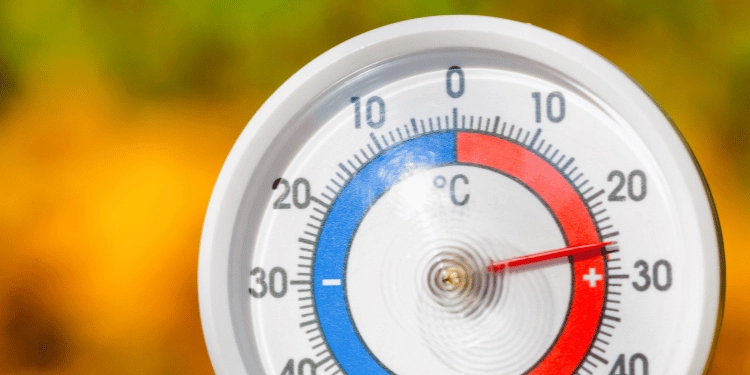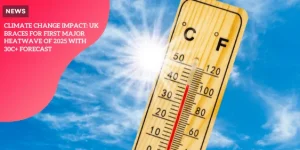UK Experiences Warmest Spring on Record Amid Growing Heatwave Concerns
A Historic Shift in Seasonal Weather Patterns
The United Kingdom has just experienced its warmest spring since temperature records began in 1884, according to the latest provisional figures released by the Met Office.
With an average temperature of 9.5°C recorded between March and May, this year’s spring has surpassed all previous seasonal averages.
These findings not only mark a historical climatic event, but also serve as a strong indicator of long-term changes in the nation’s weather patterns — a shift increasingly defined by higher temperatures, drier spells, and an elevated risk of heatwaves.
Climate Trends: Warmer and Drier Springs Becoming the Norm
According to the Met Office, the spring of 2025 was 1.4°C warmer than the long-term average for this time of year.
This deviation, while seemingly minor on paper, carries profound implications for how the UK is responding to a changing climate.
Remarkably, eight of the ten warmest UK springs on record have taken place since 2000.
Even more striking, the top three warmest springs — including this year’s — have all been recorded since 2017.
This pattern of rising springtime temperatures is no longer considered a statistical anomaly.
Rather, it reflects a systemic climatic transformation taking place across the British Isles.
A Record-Breaking Season in Numbers
The Met Office’s provisional data shows that the 9.51°C average for spring 2025 edges past last year’s record of 9.37°C.
This new high surpasses previous benchmarks set in 2011 (9.12°C), 2014 (9.02°C) and 2007 (9.02°C).
While these records may appear marginally different from one another, the consistent upward trend over the past two decades underscores the accelerating pace of warming.
Alongside these temperature milestones, this spring also ranks among the driest in over 50 years, adding another layer of concern over the impacts of prolonged dry spells on agriculture, water supplies, and natural ecosystems.
Expert Insight: The Climate Conversation Gains Urgency
Met Office climate scientist Emily Carlisle commented on the findings, highlighting that the data illustrates an undeniable pattern of change.
“The data clearly shows that recent decades have been warmer, sunnier, and often drier than the 20th century average,” she explained.
“This spring shows some of the changes we’re seeing in our weather patterns, with more extreme conditions, including prolonged dry, sunny weather.”
This view aligns with the increasing agreement among climate scientists that weather patterns in the UK are becoming more erratic and less predictable.
Summer Outlook: Elevated Temperatures and Frequent Heatwaves Ahead
Looking ahead, the Met Office has issued a three-month outlook that points to a significantly increased probability of a hot summer.
According to their models, it is now 2.3 times more likely than average that the UK will experience above-normal temperatures during the summer months — June through August.
Typically, average summer temperatures in the UK range between 10°C and 17°C, with the South East seeing the highest averages, often peaking around 16–17°C.
However, the current outlook indicates that temperatures could frequently surpass these norms.

Heatwaves Possible, But Not Guaranteed
Despite the increased likelihood of hot conditions, the Met Office has urged the public not to misinterpret the data as a guarantee of sustained heatwave conditions.
A higher likelihood of above-average temperatures does not necessarily mean there will be extended periods of hot weather or heatwaves.
Instead, the forecast suggests a more nuanced picture — a mix of hot and cooler days, possibly accompanied by warm nights and occasional spikes in daytime temperatures, rather than a continuous heatwave.
Ten Years Since a Cool Summer Forecast
Remarkably, it has been a full decade since the last cool summer forecast was issued in the UK, which occurred in 2015.
Since then, every summer has either met or exceeded expected temperature thresholds.
This shift has implications for sectors ranging from public health and energy consumption to agriculture and tourism.
The Met Office’s long-range forecast also suggests that rainfall and wind speeds for the summer months are expected to be close to average.
This consistency in precipitation, combined with hotter temperatures, could create challenging conditions for water management, especially in areas already dealing with reduced reservoir levels following a dry spring.
Public Awareness and Preparedness Must Improve
The consistent rise in average seasonal temperatures brings with it a growing need for public education and readiness.
As the risk of heatwaves and associated health hazards becomes more common, it is crucial for both local councils and the NHS to ramp up heat-health alerts, hydration campaigns, and community support programmes for vulnerable populations.
This group includes seniors, young children, and individuals with ongoing medical conditions.
Energy Demand and Infrastructure Pressure
Rising summer temperatures also put considerable strain on energy grids, as more people turn to fans, air conditioning, and refrigeration to cope with the heat.
This increased demand could test the capacity of older infrastructure, particularly in urban centres where heat island effects further amplify temperatures.
Planning for resilience will require a coordinated approach from government bodies, utility providers, and local authorities.
Urban Planning and Climate Resilience
City planners and developers will also need to consider the implications of this warming trend.
With hotter summers becoming more common, urban designs may need to evolve to include greener public spaces, better ventilation in housing, and increased tree coverage to mitigate heat retention.
Sustainable architecture and infrastructure improvements are becoming urgent necessities rather than distant goals.
The Broader Picture: UK Climate as Part of a Global Shift
While this spring’s temperature record is a local development, it forms part of a much larger, global narrative.
The UK’s recent weather aligns with worldwide trends, where spring and summer temperatures are rising due to accelerated greenhouse gas emissions, urban expansion, and loss of natural climate buffers like forests and wetlands.
This convergence of data and lived experience is reinforcing the need for more aggressive climate action, both at the policy level and within individual communities.
Conclusion: A Wake-Up Call That Cannot Be Ignored
Spring 2025 has not just been warm — it has been a clear warning.
The UK’s record-breaking temperatures, coupled with an increased likelihood of summer heatwaves, underline the urgency of climate adaptation.
While forecasts provide valuable guidance, it is our response to these trends that will determine how successfully the UK manages the long-term impacts of a warming climate.
From government strategy to grassroots awareness, now is the time to act — not just to brace for hotter seasons, but to build resilience for the future.






